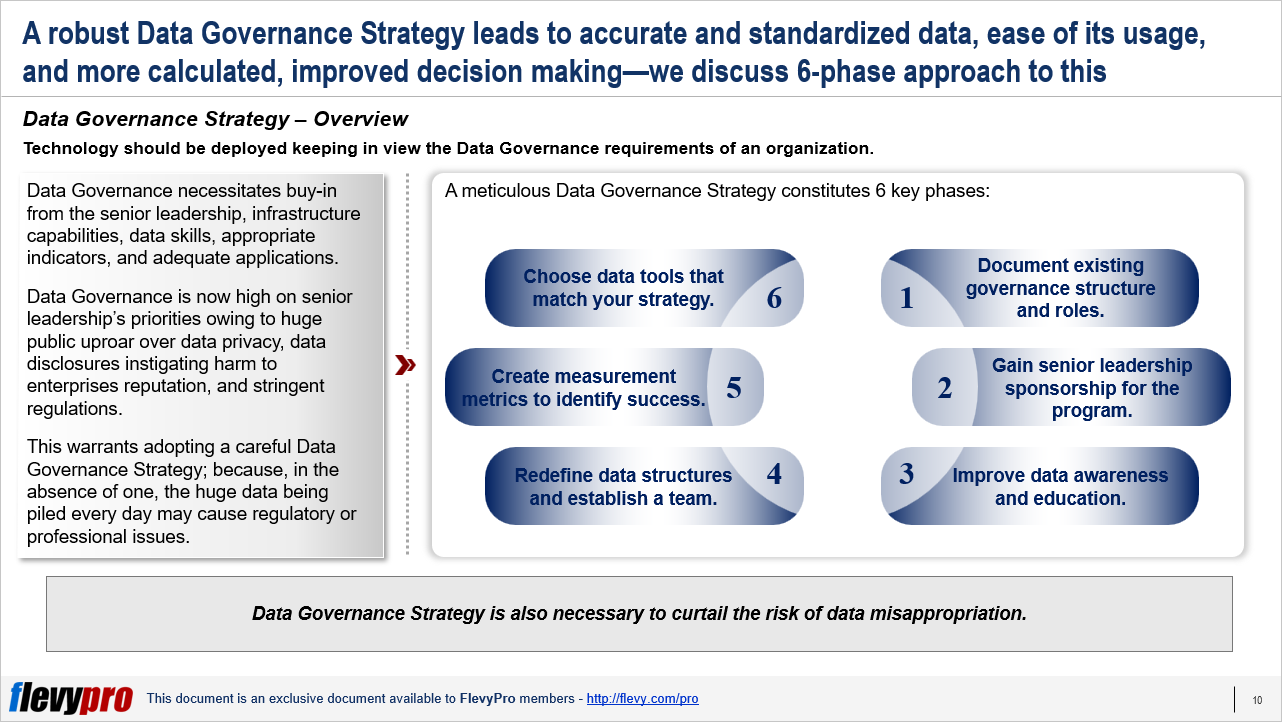 Data Governance is imperative to create a data-centric, insight-driven organization. Governance is now high on senior leadership’s priorities owing to huge public uproar over data privacy, data disclosures instigating harm to enterprises’ reputation, and stringent regulations.
Data Governance is imperative to create a data-centric, insight-driven organization. Governance is now high on senior leadership’s priorities owing to huge public uproar over data privacy, data disclosures instigating harm to enterprises’ reputation, and stringent regulations.
This warrants adopting a careful Data Governance Strategy; since in the absence of one, the huge data being piled every day tend to cause regulatory or professional issues. A Data Governance Strategy is the foremost step towards upgraded data capabilities, development of data professionals, and a collaborative enterprise.
Six steps are critical to develop a pragmatic Data Governance Strategy:
- Document existing governance structure and roles
- Gain senior leadership sponsorship for the program
- Improve data awareness and education
- Redefine data structures and establish a team
- Create measurement metrics to identify success
- Choose data tools that match your strategy
This 6-phase Data Governance Strategy enhances how the business is managed and assists in recognizing and valuing data as a significant business asset. The Strategy assists in creating accurate and standardized data, enhances its usability, and enable more calculated Decision making.
Phase 1 – Document Existing Governance Structure and Roles
The foremost phase marks the recognition of existing data management practices that are typically managed by the database administrators (access permissions), IT people (who back up and store data) and networking professionals (who ensure availability of licensed business intelligence applications) at the organization. Some form of Data Governance is followed by every enterprise though it is not available in the shape of a policy document.
Once the existing governance structure and roles have been distinguished, there is a need to make a formal inventory of data assets, identify the people responsible for handling data; and identify gaps in the data assets, responsibilities of relevant people, and processes.
Phase 2 – Gain Senior Leadership’s Sponsorship For the Program
The next phase emphasizes on the value of acquiring executive sponsorship for the triumph of a Data Governance program. Data Governance Strategy roles typically are handled by engineers, developers, and network administrators, operating in departmental silos. A workable, cross-departmental Governance Strategy cannot be developed and implemented without active support from the senior leadership.
In order to earn executive support for Data Governance programs executive leadership typically choose the option of promoting trepidation and ambiguity—for instance, charging penalties on violating data privacy and protection regulations. However, this method generates antagonism and displeasure among the stakeholders, and is destructive in governing data. A better alternative is to make Data Governance attractive for executives by demonstrating to them the benefits of Data Governance in making the enterprise more efficient and flexible.
Phase 3 – Improve Data Awareness and Education
This phase of the Data Governance Strategy entails improving data literacy across the enterprise. For Data Governance Strategy and initiatives to succeed, support from the employees is just as essential as leadership’s support. Awareness of the value of data is critical for the people to understand the significance of protecting information resources.
Lack of awareness, discovery, and reuse of data assets already created by people in an organization is a common glitch even in data-centric organizations. It’s the main reason for rework and duplication of effort resulted by creating entire databases and dashboards again. Developing and conducting employee training programs on data literacy and Data Science competencies improves Data Governance Strategy and implementation.
Interested in learning more about the other phases of Data Governance Strategy? You can download an editable PowerPoint on Data Governance Strategy here on the Flevy documents marketplace.
Do You Find Value in This Framework?
You can download in-depth presentations on this and hundreds of similar business frameworks from the FlevyPro Library. FlevyPro is trusted and utilized by 1000s of management consultants and corporate executives. Here’s what some have to say:
“My FlevyPro subscription provides me with the most popular frameworks and decks in demand in today’s market. They not only augment my existing consulting and coaching offerings and delivery, but also keep me abreast of the latest trends, inspire new products and service offerings for my practice, and educate me in a fraction of the time and money of other solutions. I strongly recommend FlevyPro to any consultant serious about success.”
– Bill Branson, Founder at Strategic Business Architects
“As a niche strategic consulting firm, Flevy and FlevyPro frameworks and documents are an on-going reference to help us structure our findings and recommendations to our clients as well as improve their clarity, strength, and visual power. For us, it is an invaluable resource to increase our impact and value.”
– David Coloma, Consulting Area Manager at Cynertia Consulting
“FlevyPro has been a brilliant resource for me, as an independent growth consultant, to access a vast knowledge bank of presentations to support my work with clients. In terms of RoI, the value I received from the very first presentation I downloaded paid for my subscription many times over! The quality of the decks available allows me to punch way above my weight — it’s like having the resources of a Big 4 consultancy at your fingertips at a microscopic fraction of the overhead.”
– Roderick Cameron, Founding Partner at SGFE Ltd










